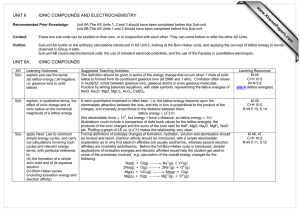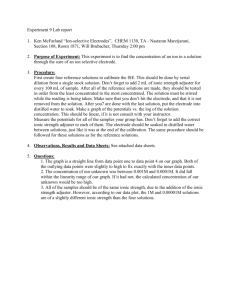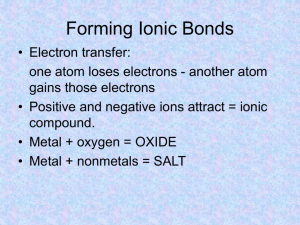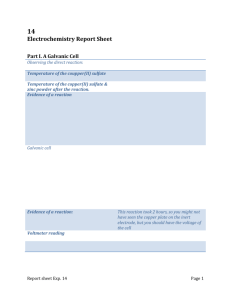UNIT 6 IONIC COMPOUNDS AND ELECTROCHEMISTRY
advertisement
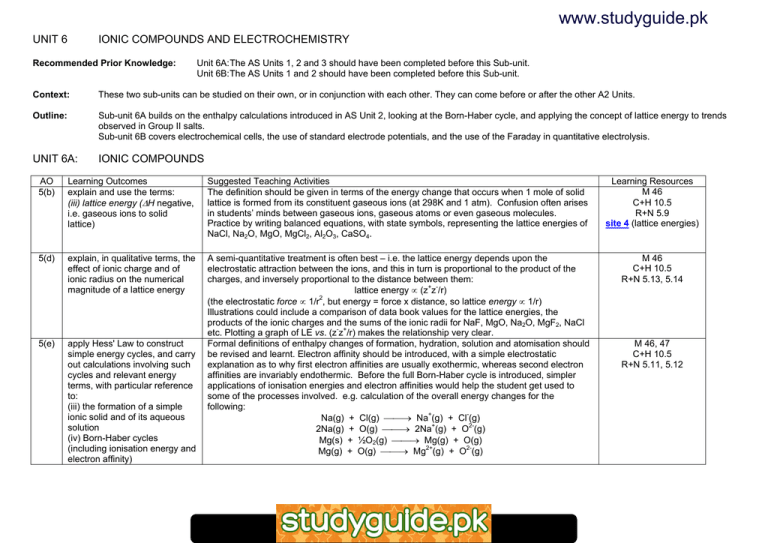
www.studyguide.pk UNIT 6 IONIC COMPOUNDS AND ELECTROCHEMISTRY Recommended Prior Knowledge: Unit 6A: The AS Units 1, 2 and 3 should have been completed before this Sub-unit. Unit 6B: The AS Units 1 and 2 should have been completed before this Sub-unit. Context: These two sub-units can be studied on their own, or in conjunction with each other. They can come before or after the other A2 Units. Outline: Sub-unit 6A builds on the enthalpy calculations introduced in AS Unit 2, looking at the Born-Haber cycle, and applying the concept of lattice energy to trends observed in Group II salts. Sub-unit 6B covers electrochemical cells, the use of standard electrode potentials, and the use of the Faraday in quantitative electrolysis. UNIT 6A: IONIC COMPOUNDS AO 5(b) Learning Outcomes explain and use the terms: (iii) lattice energy (ΔH negative, i.e. gaseous ions to solid lattice) Suggested Teaching Activities The definition should be given in terms of the energy change that occurs when 1 mole of solid lattice is formed from its constituent gaseous ions (at 298K and 1 atm). Confusion often arises in students’ minds between gaseous ions, gaseous atoms or even gaseous molecules. Practice by writing balanced equations, with state symbols, representing the lattice energies of NaCl, Na2O, MgO, MgCl2, Al2O3, CaSO4. Learning Resources M 46 C+H 10.5 R+N 5.9 site 4 (lattice energies) 5(d) explain, in qualitative terms, the effect of ionic charge and of ionic radius on the numerical magnitude of a lattice energy M 46 C+H 10.5 R+N 5.13, 5.14 5(e) apply Hess' Law to construct simple energy cycles, and carry out calculations involving such cycles and relevant energy terms, with particular reference to: (iii) the formation of a simple ionic solid and of its aqueous solution (iv) Born-Haber cycles (including ionisation energy and electron affinity) A semi-quantitative treatment is often best – i.e. the lattice energy depends upon the electrostatic attraction between the ions, and this in turn is proportional to the product of the charges, and inversely proportional to the distance between them: lattice energy ∝ (z+z-/r) 2 (the electrostatic force ∝ 1/r , but energy = force x distance, so lattice energy ∝ 1/r) Illustrations could include a comparison of data book values for the lattice energies, the products of the ionic charges and the sums of the ionic radii for NaF, MgO, Na2O, MgF2, NaCl etc. Plotting a graph of LE vs. (z-z+/r) makes the relationship very clear. Formal definitions of enthalpy changes of formation, hydration, solution and atomisation should be revised and learnt. Electron affinity should be introduced, with a simple electrostatic explanation as to why first electron affinities are usually exothermic, whereas second electron affinities are invariably endothermic. Before the full Born-Haber cycle is introduced, simpler applications of ionisation energies and electron affinities would help the student get used to some of the processes involved. e.g. calculation of the overall energy changes for the following: + Na(g) + Cl(g) ⎯⎯→ Na (g) + Cl (g) + 2Na(g) + O(g) ⎯⎯→ 2Na (g) + O2-(g) Mg(s) + ½O2(g) ⎯⎯→ Mg(g) + O(g) Mg(g) + O(g) ⎯⎯→ Mg2+(g) + O2-(g) www.xtremepapers.net M 46, 47 C+H 10.5 R+N 5.11, 5.12 www.studyguide.pk 9.2(g) 9.2(h) interpret and explain qualitatively the trend in the thermal stability of the nitrates and carbonates in terms of the charge density of the cation and the polarisability of the large anion interpret and explain qualitatively the variation in solubility of the sulfates in terms of relative magnitudes of the enthalpy change of hydration and the corresponding lattice energy Arguments based on both lattice energies and ion polarisation have been used to explain these trends. Since these reactions are usually not carried out under equilibrium conditions, the decreasing rate of reaction as the group is descended is the important feature, and this is best explained by the polarisation of one of the O-N or O-C bonds in the anion by the cation, causing 2+ its eventual fission into O and CO2 (or “NO2 ”, which then reacts with NO3 to give 2NO2 + ½O2) Repeating the AS experimental work on heating nitrates will allow students to place this topic in context. Here we do have an equilibrium, between the ions arranged in the solid lattice, and freely solvated in solution. Although the importance of enthalpy change of hydration and lattice energy should be pointed out, in the form of a Hess’s Law triangle, the argument is a subtle one, since both of these terms will decrease as the group is descended. The latter decreases less than the former, however, due to the large size of the sulfate ion preventing the smaller 2+ 2+ ions (Ca and Mg ) from making full use of their small ionic radii to increase lattice energy. [The lattice energy of MgSO4 is only 500 kJ mol-1 more than that of BaSO4, whereas the ΔHhyd(M2+) is 620 kJ mol-1 more]. Students can search for ΔHhyd values in data sources (data books, internet) and perform the calculations themselves, showing that ΔHsolution becomes more endothermic down the group. www.xtremepapers.net M 93, 97 C+H 16.4 R+N 5.16, 5.17, 10.12 M 60, 93 C+H 10.6, 16.5 R+N 10.13 site 8 (Group II) www.studyguide.pk UNIT 6B: ELECTROCHEMISTRY AO 6(c) Learning Outcomes define the terms: (i) standard electrode (redox) potential (ii) standard cell potential 6(d) describe the standard hydrogen electrode 6(e) describe methods used to measure the standard electrode potentials of: (i) metals or non-metals in contact with their ions in aqueous solution (ii) ions of the same element in different oxidation states 6(f) calculate a standard cell potential by combining two standard electrode potentials 6(g) use standard cell potentials to: (i) explain/deduce the direction of electron flow from a simple cell (ii) predict the feasibility of a reaction 6(h) construct redox equations using the relevant halfequations (see also Section 9.4) 6(i) predict qualitatively how the value of an electrode potential Suggested Teaching Activities Introduce the terms Eoelectrode and Eocell. Formal definitions should include reference to temperature (298 K), pressure (1 atm), concentration (1 mol dm-3) and the use of the standard hydrogen electrode (S.H.E.) as reference (Eo = 0.000 V). [Point out that it is not possible to measure the electrode-solution voltage directly, without introducing another conductor into the solution, and hence another voltage.] Include the electrode equation, and the use of platinised platinum (“platinum black”) as the electrode. Point out that the internal resistance is quite high due to the adsorbed H2(g), necessitating the use of a high-resistance voltmeter to measure voltage. Explain the need for a salt bridge between the two electrodes, and explain how it works. Point out that if the voltmeter has a high resistance, little current will flow through the cell, and so little contamination from the ions in the salt bridge will occur. After the use of the S.H.E. has been demonstrated to measure the Eo for, say, Cu+(aq)/Cu(s), this (more convenient) electrode can then be used as a secondary standard. Practical work could include the following electrodes: Zn2+/Zn, Fe2+/Fe, Fe3+/Fe2+, Ni2+/Ni, I2/I-. Emphasise the importance of the sign of the voltage. Although 1 mol dm-3 solutions should be used to measure Eo values, the use of 0.1 mol dm-3 solutions is more economical, and will not cause the cell voltages to differ significantly from their standard values. Students are always impressed by the additive nature of Eo values – ask them to predict Eocell values for various combinations of the above electrodes before they measure them by using the equation Eocell = Eoright - Eoleft. Once again, emphasise the importance of the sign of the Eocell, and get them to relate the calculated sign to the measured polarity of the two electrodes. Learning Resources M 66 C+H 13.1 R+N 6.3 site 3 (electrochemistry) M 66 C+H 13.1 R+N 6.4 M 66 C+H 13.1 R+N 6.5 P(A2) 1 site 8 (electrochemistry) M 66 C+H 13.1 R+N 6.6 site 10 (standard reduction potentials) M 70 C+H 13.2 R+N 6.7 P(A2) 2 Much confusion seems to occur when Eo values are subtracted, and this sometimes happens when student have been taught to reverse the sign of one of the Eo values before adding them. It is best always to use reduction potentials, and never oxidation potentials. If the equation Eocell = Eoright - Eoleft is used, the sign of Eocell gives the polarity of the right hand electrode. Electrons will flow around the external circuit from the negative electrode. In a reaction involving two redox half-equations, the system with the more positive Eo will act as the oxidising agent, whilst that with the more negative Eo will be the reducing agent. Reaction between the reduced species of the more positive system and the oxidised species of the more negative system will not therefore be feasible. Choose suitable pairs of reagents from the Eo list in the Data Booklet and ask students to predict what reaction might take place. They can then try out their predictions in the lab! Applications of Eo values to Group IV and Transition Element chemistry are covered in sub-units 8A and 8B respectively. Include here the use of Eo values and their associated half-equations in constructing equations involving the halogens, KMnO4, K2Cr2O7, Fe2+, Sn2+, Zn, and a selection of others from those listed in the Data Booklet. Practice with balancing these equations, making sure that the electrons ‘cancel out’ on each side. M 66 C+H 13.1 R+N 6.8 site 7 (N-ch5-12) site 9 (redox reactions) A consideration of the redox half-equation for an electrode (and especially what happens to the electron(s) formed during the oxidation) will result in a prediction that the potential of an M 67 C+H 13.3 www.xtremepapers.net www.studyguide.pk varies with the concentration of the aqueous ion 6(j) 6(l) 6(k) 6(m) 6(n) state the possible advantages of developing other types of cell, e.g. the H2/O2 fuel cell and improved batteries (as in electric vehicles) in terms of smaller size, lower mass and higher voltage predict the identity of the substance liberated during electrolysis from the state of electrolyte (molten or aqueous), position in the redox series (electrode potential) and concentration state the relationship, F = Le, between the Faraday constant, the Avogadro constant and the charge on the electron calculate: (i) the quantity of charge passed during electrolysis (ii) the mass and/or volume of substance liberated during electrolysis, including those in the electrolysis of H2SO4 (aq); Na2SO4(aq) describe the determination of a value of the Avogadro constant by an electrolytic method electrode system will become more negative if the concentration of the reduced species is increased, and vice versa. For ion-ion equilibria (e.g. Fe3+/Fe2+), if both concentrations are changed by the same amount, no change in electrode potential should be observed. Practical work can be done with Cu2+/Cu, Fe3+/Fe2+, I2/I-, measuring Eo as concentrations vary. An internet search by students will be useful here to investigate current developments. The principle of the H2/O2 fuel cell should be covered, including the reactions involved, the E.M.F. generated, and the problems with taking a high current from the cell (high internal resistance, and slow equilibration at the gas-electrode interface). Other low-mass alternatives to conventional batteries, such as the sulfur-sodium cell and alcohol fuel cells, could be mentioned. R+N 6.9 M 66 C+H 13.5 R+N 6.10 Systems that could be studied include NaCl (molten, concentrated solution and dilute solution) and the way impurity metals are separated from copper during its industrial electrochemical purification (see AS Unit 2). Very dilute solutions of NaCl(aq) are needed if no chlorine is to be liberated along with oxygen, due to the large overvoltage for oxygen. This need not be explained in detail, however. In general, the electrolysis of aqueous solutions of electropositive o elements (E < 0.0V) results in the formation of hydrogen at the cathode. M 72 C+H 13.4 R+N 6.12 The knowledge that the Faraday is a mole of electrons, and has a value of 9.65 x 104 C mol-1, will be used in electrolysis calculations. M 72 C+H 13.4 The relationship between current, time and quantity of charge (C = i x t) needs to be covered. Dividing this quantity by the Faraday gives the number of moles of electrons. This can be related to the number of moles of substance (and hence its mass or volume) by the relevant half-equation. Calculations should be practiced involving volumes of H2 or O2, and masses of Cu and other metals. Practical work could involve measuring mass during the electrolysis of CuSO4(aq) or volume during the electrolysis of H2SO4(aq) in a Hofmann voltammeter [a cheaper alternative comprises 2 upturned burettes over two electrodes glued into holes made in the bottom of an upturned plastic beaker]. Practical work could included measuring either the mass of copper liberated during the electrolysis of CuSO4(aq) or the volume of hydrogen during the electrolysis of H2SO4(aq). From these results a value for L can be calculated, assuming knowledge of the valencies concerned, the Ar (or molar volume), and the charge on the electron. Practice calculations of L using these systems. M 72 C+H 13.4 R+N 6.13 P(A2) 4 www.xtremepapers.net C+H 13.4 R+N 6.14 P(A2) 3
